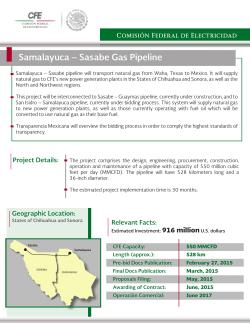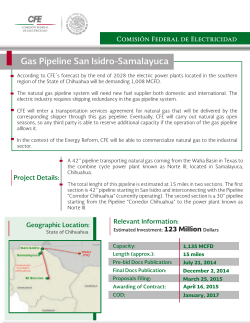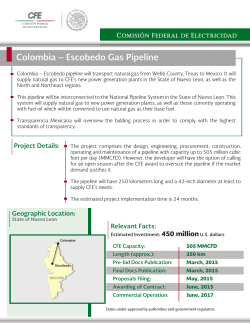
Highlanders for Responsible Development - Allegheny
Highlanders for Responsible Development P.O. Box 685 Monterey, VA 24465 www.protecthighland.org April 28, 2015 Kimberly D. Bose, Secretary Federal Energy Regulatory Commission 888 First Street, NE, Room 1A Washington, DC 20426 Re: Docket No. PF15-6-000, scoping comments Dear Secretary Bose: Highlanders for Responsible Development (HRD) is a citizens group dedicated to the preservation and responsible use of the natural environment in Highland County, Virginia. Highland has the smallest population and the highest mean elevation of any county east of the Mississippi River. The headwaters for both the James and Potomac Rivers are in our county, which is also home to bald and golden eagles, native brook trout, many rare species of birds, and high elevation flora and fauna. The proposed Atlantic Coast Pipeline (ACP) would be the largest construction project ever undertaken in Highland County. Should the Federal Energy Regulatory Commission (FERC) approve any of the routes that have been reported to be under consideration for the ACP, there would be far-ranging, long-lasting impacts that threaten the many features that make our county so unique: water, topography, vegetation and animal species and habitats. Moreover, it would disrupt and diminish the commerce and quality of life of the county and its residents. FERC’s February 27 Notice to Prepare an Environmental Impact Statement (EIS) for the ACP invites comments on a range of impacts under certain specific headings. It also lists several issues already identified by the agency that it deems deserving of attention. HRD offers the following comments on several of those items and urges FERC to give serious consideration to our concerns as it prepares the EIS. A pipeline built along the announced routes under consideration would seriously threaten the integrity and safety of the water supplies for many county residents, particularly those in the towns of Monterey and McDowell. In both towns residents are supplied by water systems drawing from aquifers that would be adversely affected by construction of the pipeline. This issue is discussed in a recent newspaper article in our local paper, The Recorder. (Appendix A) One passage in the article reports that when the Mayor of 1 Monterey, Richard S. Holman, expressed a concern to a Dominion Resources representative about the threat to the town’s water supply by the proposed pipeline and asked that Dominion issue a bond to guarantee against harm to the town’s water supply. He was rebuffed and told to take up the matter with FERC. This flagrant demonstration of Dominion failing to take responsibility for a problem caused by its proposed project is of serious concern to Highland County residents. It should also be a serious concern to FERC. This conversation is also referenced in a letter sent to FERC on April 23, 2015 by the Mayor conveying to the agency a report prepared by a consulting hydrologist, William K. Jones, that addresses the adverse impacts on Monterey’s water supply should the ACP be built along of the proposed routes. Mr. Jones observes that should a pipeline be built through Highland County, even one with a route farther away from Monterey’s current wells, “the contractors should be held to a very high standard in this sensitive and relatively undisturbed natural setting.”1 (Appendix B) We request that FERC insist upon a bond to insure against damage to the water supplies of McDowell or Monterey should the agency approve the project. There are serious safety risks associated with the construction of a pipeline through Highland County because of the proven instability of the karst topography that exits in the county. Several experts made statements at the scoping meetings2 that vividly described the inherent instability of karst topography to support a pipeline infrastructure such as the ACP. While Dominion spokespersons have proclaimed that karst topography would not present a serious problem for its construction of the ACP, other Dominion representatives have made statements to the contrary. At the August 13, 2014 briefing Dominion presented to the Augusta County, VA Board of Supervisors, Supervisor Larry Willis noted the great prevalence of karst formations in Augusta County and asked what steps “will you be taking to prevent pipeline cracking and failure in the future because of the rock formations?” Bill Scarpinato, Dominion Resources’ Environmental Manager, responded that the company would “avoid that type of geologic formation when we encounter it. The reason being that its construction would not be the best suitable.” Brittany Moody, a Dominion Transmission, Inc. engineer, further commented that “we don’t want to put our pipe in that situation. So, if it’s something we can see up front, we’re going to move around it.”3 Mr. Jones is a world-recognized expert in hydrology and karst topography, particularly in the Appalachian regions of Virginia and West Virginia. 2 Statements discussing features of karst topography in the Appalachian/Blue Ridge area and the challenges presented by constructing the ACP were presented at the Stuarts Draft, VA scoping meeting on March 19, 2015 by Diane Korte and Larry Korte, and at the Elkins, WV scoping meeting on March 23, 2015 by Art Dodds, Pamela Dodds and Rick Lambert. 3 The comments attributed to Supervisor Wills, Mr. Scarpinato and Ms. Moody are extracted from a verbatim transcript of the Augusta Board of Supervisors meeting of August 13, 2014. 1 2 At several of the open houses that Dominion Resources conducted in September 2014 similar comments were made by Dominion representatives that the ACP route would avoid karst topography. However, it is not possible to build a pipeline through Highland County without encountering karst topography and creating the prospect of safety problems because of the instability of the rock formations. The previously referenced report in Appendix B discusses this further. Another safety concern involves the perils of constructing a pipeline over the steep and rugged terrain of Highland County. The possibility of accidents during construction or mishaps after a pipeline is in operation was an expressed concern of Highland County’s Board of Supervisors when that body was briefed in early August 2014 by representatives of Dominion. The Supervisors pointed out the county’s limited resources to respond to workplace accidents or a pipeline mishap and asked what assistance Dominion could guarantee it would provide in such circumstances. The company’s response then and since has been remarkably evasive and unconvincing, much like its response to the Mayor of Monterey regarding his concern about the town’s water supply. FERC must insist on a higher standard of accountability for the ACP. Building a pipeline through Highland County would not be business as usual and shouldn’t be treated as such. Building the ACP through the rugged and steep mountain terrain that predominates in Highland County would endanger the structural character of the mountains it crosses and seriously increase the possibility of long-term erosion. Dominion has indicated it wishes a waver to a Commonwealth of Virginia regulation limiting an open trench to be no more than 500 linear feet at a time. This standard exists for erosion and sediment control, a critical concern in terrain as steep as that which exists in Highland County. Dominion wishes to have the right to open a trench as long as 2000 feet. Should such a waiver be granted the potential for serious erosion and mudslides in heavy rains – which are frequent in Highland County – is profound. FERC should insist that the current 500 foot limitation be adhered to. The ACP routes proposed would harm the habitat of many protected species of plants and animals that are unique to the Allegheny-Blue Ridge region. For instance, the portion of Shenandoah Mountain, located along the eastern border of Highland County, over which the ACP would pass is home to the Cow Knob Salamander, a protected species that is subject to a conservation agreement between the U.S. Forest Service and the U.S. Fish and Wildlife Service.4 A pipeline built along any of the contemplated routes would seriously impair the habitat of this rare species. There would be other adverse impacts on wildlife should the pipeline be built along these routes. As FERC knows from other projects it has overseen, whenever a pipeline such as the ACP is built through habitats of bear and wild turkey, these species abandon those areas and do not return for several years. Memorandum of Understanding 94-SMU-058 between the U.S. Forest Service, U.S. Fish and Wildlife Service and the National Marine Fisheries Service, January 25, 1994. 4 3 The routing of the Atlantic Coast Pipeline through Highland County would diminish the value of private property and adversely affect innumerable cultural and recreational features of our county. The effect of natural gas pipelines on property values has not been documented extensively. The studies that have been published (most of which having been commissioned by natural gas companies) have been based upon before and after sales records of suburban communities where the principal motivation for people to purchase homes is location to work. The motivation for people to purchase property in Highland County is a desire to live in our rural community with its many natural resource attributes. There is already a reduced demand for property in Highland County due to the very prospect of a pipeline bisecting the county. That view is not conjecture, but based on conversations that local Realtors have had with prospective buyers of property in the county. This circumstance has a dampening effect upon property values, which in turn will reduce property tax revenues for local government. Tourism is an important and growing part of Highland County’s economy. The construction of the ACP along the routes that have been proposed would cause considerable disruptions for tourists and the businesses that serve them. If the pipeline is built there would be a profound, long-lasting effect on the county’s attractiveness as a tourism destination. People visit and move to Highland County because of is unique beauty and natural resource attributes. For instance, Dominion’s preferred route through Highland would bisect the beautiful Blue Grass Valley and the 200+ year-old Hevener farm. This farm includes the headwaters for both the Potomac and James Rivers. The farm also includes one of the most valuable stands of sugar maple trees in the Allegheny Highlands, which would be destroyed should the pipeline be built along that route. The effect would be not only to permanently scar one of the most iconic and important agricultural settings in Virginia (the Hevener farm) but to destroy the business of one of the county’s largest maple syrup producer, who has depended for decades upon the output from that maple tree stand. Maple syrup production is one of the important attractions in Highland County and is the basis for the annual Maple Sugar Festival, the largest tourist attraction event in our county and one of the most notable events of its kind in Virginia. These are issues that have been raised with Dominion by the owners of the farm and local officials, but without satisfactory responses. There are several other businesses in Highland County that would be adversely and permanently affected by the proposed routes. None have been able to engage in a meaningful dialogue with Dominion about their concerns. The proposed routes could adversely impact several conservation easements in Highland County. Conservation easements are an important tool to protect and conserve critical ecological and open space features of land from inappropriate development. Because of the interstate nature of the proposed ACP, the eminent domain powers that have been granted could trump affected conservation easements along the chosen route. This would be an unwelcome and unusual result for the impacted landowners and for Highland County as a whole, which depends upon these protected lands to enhance its attractiveness for tourism and agriculture. 4 Your invitation for comments during the scoping period are focused upon receiving input relative to the agency’s preparation of an Environmental Impact Statement. However, I take this opportunity to raise some other serious questions that are central to your consideration of the Atlantic Coast Pipeline’s application to FERC: the economic justification for the pipeline. The premise for ACP’s application, as announced by the company last May, is that: 1) there is an unending supply of natural gas reserves in the West Virginia Marcellus shale field in West Virginia;5 2) there is a growing demand for natural gas in North Carolina and southeast Virginia markets, particularly due to the U.S. Environmental Protection Agency’s requirement that coal-fired power plants be converted to natural gas; and 3) considerable economic benefits would flow to all the communities affected and served by the proposed pipeline. There is one other pipeline application pending before FERC that seeks to serve the same general market (Mountain Valley Pipeline, MVP) and a third that has been announced (Appalachian Connector project by Transco). This raises several very basic questions of economics that have not been addressed by the partner companies of the ACP or MVP. 1) What is the projected need for more natural gas to serve the proclaimed markets by these pipeline projects? It should not be assumed that the need exists simply because the applicants says it does. Economic justification should be required. 2) What is the realistic likely life of the Marcellus Shale field in West Virginia to supply natural gas to the markets that would be served by the ACP or MVP? There have in recent months been several studies suggesting that the Marcellus field will reach peak production by or before 2020 and then begin to decline. What does this mean for the long-term need and economic viability of the ACP or MVP? 3) Whatever the future demand level for natural gas in the southeast Virginia and North Carolina markets that the ACP and MVP intend to serve, what is the adequacy of existing pipelines to serve those markets? Several recent studies have suggested there is unused capacity in the pipeline networks serving these markets and that the call for more pipelines is overstated. In particular, the U.S. Department of Energy issued a report in February 2015 on the infrastructure implications of increased demand from the electric power sector. One of the study’s key findings was: “Higher utilization of existing interstate natural gas pipeline infrastructure will reduce the need for new pipelines.”6 Another report worth examining is a document released last summer by the Natural Gas Supply Association, “Twenty Questions About Natural Gas Performance During Winter 2013-2014.”7 The report provides a useful perspective that has been missing from A Dominion executive, in answer to a question posed to him at the Augusta County Board of Supervisors briefing last August about how long the pipeline would be usable, suggested that the supply of natural gas from the West Virginia field would be reliably flowing for 70-100 years. 6 “Natural Gas Infrastructure Implications of Increased Demand from the Electric Power Sector,” U.S. Department of Energy, February 2015, p. vi (http://energy.gov/sites/prod/files/2015/02/f19/DOE%20Report%20Natural%20Gas%20Infrastructure %20V_02-02.pdf) 7 http://www.ngsa.org/winter-2013-14-market-conditions-frequently-asked-questions/#four 5 5 the current discussions about the need for new pipelines. It notes that natural gas prices in the 2013-14 winter reached a 5-year high, but were still half of what they were in 2003. The report also notes that pipeline adequacies were only a problem in New England.8 We ask that FERC rigorously address these foregoing questions about pipeline economics as well as our concerns about issues related to the Environmental Impact Statement that will be prepared for the proposed Atlantic Coast Pipeline. Thank you for considering our views. Sincerely, Lewis Freeman, President Highlanders for Responsible Development 6 Appendix A April 23, 2015 McDowell study advised for pipeline BY JOHN BRUCE • STAFF WRITER Danger zone Map shows MacDowell aquifer and Dominion’s preferred route for the proposed pipeline. (Courtesy RickLambert) MONTEREY — Highland supervisors learned at their April 15 work session that the county-owned McDowell water system could be in more peril than Monterey for potential contamination by construction of the proposed Atlantic Coast Pipeline. 7 Rick Lambert of Monterey, who is a member of the Virginia Speleological Society, described McDowell’s aquifer as deep, narrow and confined, making it more susceptible to erosion runoff, sedimentation and construction related contamination. He recommended supervisors write to the Federal Energy Regulatory Commission about the concern. “If you don’t bring it up, they won’t know,” Lambert said. Place the burden of performing a study of the potential impact on the aquifer on Dominion, Lambert suggested. He said an impact would not be hard to prove because the aquifer is so deep along the Bullpasture River Valley. He said streams flowing down Bullpasture Mountain are sinking streams and that as the water flows, it sinks into the aquifer. Supervisor David Blanchard asked if the town were assessing the same thing. Mayor Rich Holman said the town was following the advice of Dominion government affairs manager Emmett Toms to take its concerns to FERC. County attorney Melissa Dowd said any negative impact might happen quickly. The town voted in a special called meeting April 13 to hire William Jones, a karst specialist, to write a letter of opinion for FERC’s consideration. Dowd asked about mitigation. “You could ask them (Dominion) to move” the pipeline route, Lambert said. Dominion applied for an exemption to the open trench law, he added. He said having 2,000 feet of open trench and two inches of rain would create four times the sediment as a trench built at the 500-foot limit. It was suggested the county ask FERC to reroute the pipeline corridor and limit the trench to 500 feet. In a related matter, the Virginia Cave Board filed a 50-page report by Lambert Monday recommending measures to mitigate damage to aquifers by rerouting the preferred route away from those of Monterey and McDowell, limiting open trenches to 500 feet, establishing a preconstruction baseline of karst environment health and many other safeguards. Blanchard said any landowner needs to be aware of the open trench and that 2,000 feet “is pretty big. You might not be able to get from one side of your property to another without a bridge.” Lambert related Dominion’s Toms said, “You have to make your case to FERC.” Supervisor Lee Blagg said the county does not know exactly where the pipeline would go. Dominion told Lambert the original route that passes west of McDowell is the preferred route. No action was taken. 8 Appendix B 9 10 11 12 13 14 15 16 17 18 19 20
© Copyright 2025









